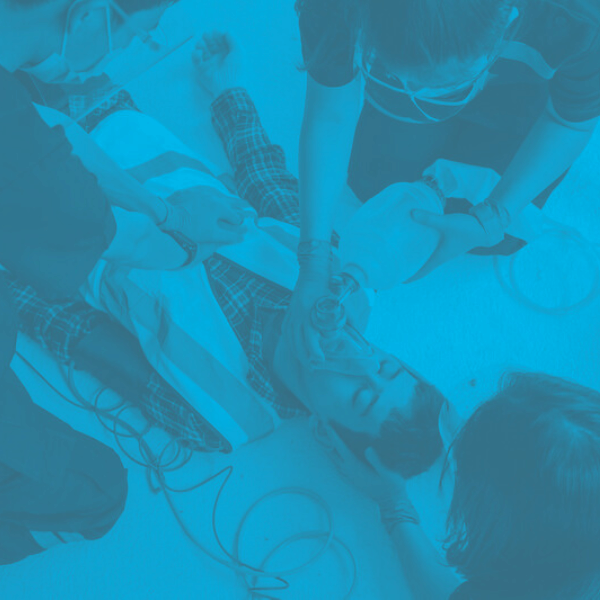Adenosine Dose Guidelines and Indications
Adenosine Dose Guidelines and Indications

by Greta Kviklyte
Life Saver, AMC
Co-authored by Kim Murray, RN, M.S.
posted on Sep 3, 2024, at 5:46 pm
Adenosine, a prescription-strength medication sold under the names Adenocard and Adenoscan, is an antidysrhythmic medication given to help stabilize the heart rate when there is an indication of paroxysmal supraventricular tachycardia (PSVT). This condition is often associated with accessory bypass tracts, such as those found in those with Wold-Parkinson-White Syndrome.
Though various indications occur, an adenosine dose can be highly effective, quickly improving patients’ heart rates.
What Is Adenosine?
We offer Online ACLS Certification and Renewal
Adenosine is a medication administered to restore normal heart rhythm, also called sinus rhythm. A medical professional injects this medication directly into the patient’s vein during a medical emergency, clinic setting, or hospital.
It may be prescribed to adults, children, and, in some cases, infants, even newborns, to restore heart rhythm to sinus rhythm. Numerous precautions are necessary when providing this medication to a child.
When and How Adenosine Is Used
As noted by StatPearls through the National Library of Medicine, an adenosine dose works as both a diagnostic and therapeutic agent. Once injected into the vein of the patient, the drug works through the purinergic adenosine receptors located throughout the body.
For Diagnostic Agents
For diagnostic use, adenosine is used in the myocardial perfusion stress imaging process. It can provide vasodilatory effects, providing indication of abnormal flow or movement of blood through the heart.
For Therapeutic Agents
Adenosine may also be used as a treatment. In this way, it works as an antiarrhythmic medication for supraventricular tachycardia (SVT). It may be used to quickly restore the function of the heart into sinus rhythm in these situations.
Dosing of Adenosine
The proper administration of an adenosine dose depends on the situation. However, the following is a common treatment process:
- The first dose of adenosine is typically 6mg and administered rapidly within 1 to 3 seconds.
- A 20 ml NS bolus is delivered.
- If the SVT does not convert within 2 minutes, a second 12 mg adenosine dose is given using the same method.
- A 20 ml NS bolus is given after.
In nearly all situations, adenosine dose administration should happen quickly to revert the heart rhythm.
Patients Taking Dipyridamole or Carbamazepine
For patients taking either dipyridamole or carbamazepine, the initial adenosine dose drops to just 3 mg. It should be given slightly slower. These two medications can impact the effectiveness of adenosine, requiring less of the dosing to achieve similar results.
Heart Transplant Patients and Central Line Use
In patients who have had a heart transplant, as well as those with a central line in use, prolonged asystole is possible with the normal adenosine dose. For this reason, it is common to provide a lower adenosine dose of 3 mg in these patients.
Indications for Use of Adenosine
As documented in the JACC Journals, adenosine is a ubiquitous extracellular signaling molecule that provides specific functionality to human physiology due to the presence of adenosine receptors throughout the body. These receptors are present in different organ systems, though they are primarily focused on coronary circulation.
Indications for use are numerous:
It can be used in patients after vagal maneuvers are completed, providing a first-line therapy for diagnosing and then treating SVTs. It may also be used as a second-line treatment that includes beta and calcium channel blockers.
Additionally, research indicates it may be helpful in reducing the risks associated with glaucoma, one of the most common causes of blindness. In this way, an adenosine A 1 receptor agonist called trabodenoson increases aqueous humor outflow by stimulating the trabecular meshwork cells’ production of matrix metalloproteinases.
Also notable, Adenosine may also be used in pediatric patients who exhibit SVT, which is rather common in very young children. If not treated immediately and effectively, it can transition to cardiogenic shock and heart failure.
The Use of Adenosine in Cardiopulmonary Resuscitation and Emergency Cardiovascular Care
Depending on the type of care provided and the standards followed, adenosines may be administered as a class 1 recommendation for hemodynamically stable STV.
In pediatric patients with SVT, the condition is often dependent on the atrioventricular node’s function to be sustained. The arrhythmia is stopped with the use of adenosine, which primarily affects the atrioventricular node. There are two primary reasons why adenosine failure occurs in STV. The first is the medication’s short half-life. The second is for non-atrioventricular node-dependent SVT.
What Is Adenosine Function in the Body?
Adenosine is, as noted by the National Library of Medicine, a purine nucleoside base with the molecule adenosine triphosphate, or ATP. It works through the receptors in the body called purinergic adenosine receptors, which impact the nervous system, immune system, respiratory system, circulatory system, and urinary systems in the body. Specifically, these receptors are in the cardiac atrioventricular nodal tissues (AV node).
It may also act on the receptors in the cardiac AV node to slow conduction times, as a result of the activation of specific potassium channels, which forces potassium out of the cells and limits calcium influx. As a result of this, it slows the nodal cardiac myocyte.
Using Adenosine In Emergency Situations
The first step in most cardiac emergencies where STV is present is to use vagal maneuvers. If this process fails to terminate stable narrow-complex SVT, adenosine is used.
In patients who are unstable but have a regular but narrow QRS complex, this medication may be used prior to cardioversion application in an effort to improve outcomes.
When given through a rapid IV bolus into the vein, the medication slows cardiac conduction related to the AV node specifically. The rapid bolus will interrupt reentry pathways, which are what causes SVT, through the AV node. This aids in returning the patient to sinus rhythm.
In emergent situations, the adenosine dose must be administered quickly. This is because the medication is rapidly absorbed by the body’s red blood cells as well as blood vessels and endothelial cells. It is then metabolized naturally through the body. Without rapid dosing, a significant impact to create changes in the heart’s rhythm prior to the medication being metabolized is often challenging.
First Dose of Adenosine for SVT
The first dose of adenosine for SVT should be a 6 mg administration over 1 to 3 seconds directly into a patient’s vein. Follow this by a 20 ml NS bolus.
Second Dose of Adenosine for SVT
Prior to considering the second dose of adenosine, practitioners should wait 1 to 2 minutes to determine if the heart reverts to normal rhythm. If it does not, a second dose may be administered. What is the second dose of adenosine? In most patients, it will be 12 mg given in the same 1 to 3 second push. It should be administered quickly.
Adenosine Side Effects
It is critical to consider the potential side effects of the use of adenosine in some patients. Some of the most common adenosine dose side effects include:
- Flushing of the face
- Brief asystole
- Brief bradycardia
- Chest pain
- Chest tightness
Notably, this medication should not be used for some arrhythmias. It should not be used for:
- Polymorphic wide-complex tachycardia
- Irregular tachycardia
- Unstable VT
When used in patients with these conditions, deterioration of health is likely to occur.
Contraindications of Adenosine
Additionally, intravenous adenosine should not be used in those with a second or third-degree A-V block unless the patient has a functioning artificial pacemaker. It should not be given to patients with sinus node disease, including sick sinus syndrome or symptomatic bradycardia (unless that patient has an artificial pacemaker that is functional).
Clinical Study of Adenosine Dose
An FDA release of information provided an update on the dosing of adenosine in most patients. In controlled studies in the US, the dosing of adenosine was observed at several levels: 3, 5, 9, and 12 mg.
The study found that 60% of patients with paroxysmal supraventricular tachycardia converted to normal sinus rhythm within one minute of the EV dosing of 6 mg. A smaller percentage of those given 3mg converted, and when they did not, 6 mg was administered. Additionally, 92% of patients were converted after a bolus dose of 12 mg was given.
The study also looked at patients given a placebo bolus injection. Of those, 7 to 16% of patients converted after being given 1 to 4 placebo injections.
The FDA notes in its research that:
- Adenosine is not effective in converting PSVT, including atrial flutter
- Atrial fibrillation
- Ventricular tachycardia
The study found similar recants across all patients in various demographics and conditions. That includes those who were using digoxin prior and those not doing so. It included those with Wolff Parkinson White Syndrome and those without.
Potential Warnings When Administrating Adenosine Dose
There are some key warnings that must be considered in providing adenosine dose instructions, as noted by the FDA:
- Heart block patients: when used, adenosine may create first-, second-, or third-degree heart block because it decreases conduction in the AV node. If a patient experiences a high-level block when given an initial dose, they should not be given a second dose.
- Arrhythmias at cardioversion: Patients may develop new rhythms at the time of cardioversion. These may initially appear on the electrocardiogram but last just a few seconds and do not require intervention. These may include premature ventricular contractions, atrial fibrillation, atrial premature contractions, since tachycardia, skipped beats, sinus bradycardia, and others.
- Bronchoconstriction: Adenosine also works as a stimulant for the respiratory system. When given through an IV, it can increase minute ventilation and reduce arterial PCO0, which can cause respiratory alkalosis. Also note that when given through inhalation, it may cause bronchoconstriction in some patients who are asthmatic.
Adenosine and Advanced Cardiac Life Support
Advanced cardiac life support (ACLS) is a life-saving set of skills designed specifically to treat cardiac emergencies. Those who do not have ACLS training may wish to obtain it to better understand how adenosine dose is applied to various types of patients in various states of cardiac health and function.
Follow these steps associated with the ACLS algorithms in patients with symptoms:
- Determine the cause of the tachycardia occurring, if possible, but do not delay treatment to do so.
- Utilize vagal maneuvers for immediate support.
- Apply synchronized cardioversion with a defibrillator if there is no improvement
- Treat with medications
- Maintain that patient’s oxygen saturation at 94% or higher.
If the patient is stable at this point, move to the ER facility for treatment. If the patient is unstable due to hypotension, decreased LOC, chest pain, or shock, move forward with care.
- Complete synchronized cardioversion
If the patient is stable, follow these steps:
- Establish an IV for the patient
- Consider the use of adenosine 6 mg bolus. If, after 2 minutes, the SVT remains, consider a second dose at 12 mg.
- If adenosine is not effective, treatment with procainamide or amiodarone
- If continued complications, consider antiarrhythmic infusion
The ACLS tachycardia process listed here is followed when patients have tachycardia, which is a fast heart rate of 150 beats per minute or more, and they have a palpable pulse. In patients where there is no palpable pulse for 10 seconds, rescuers should move to ACLS cardiac arrest treatment for Vtach or Vfib.
Follow the immediate response methods expected if a patient presents with tachycardia with a pulse. That includes:
- Maintain an open airway
- Provide breathing assistance to the patient if necessary
- Apply monitors to determine blood pressure, blood oxygenation, and cardiac rhythm
- Supplement with oxygen to maintain 02 saturation of 94% or higher.
Adenosine Dose Insights: Using Adenosine for SVT Effectively
Recognizing the importance of adenosine dose administration could save a life. It is critical for rescuers to view the use of adenosine as an emergent treatment for SVTs, and to apply the necessary ACLS algorithm to treat patients immediately with the proper dosing. In most situations of adult treatment, this begins with a first dose of 6mg followed by a second does of 12 mg if the patient does not respond within 2 minutes. For infants, the initial dose is 3mg.
For a first responder who needs to know how to CT quickly, complete your ACLS online certification to be sure you are ready to care for your patients. Your ACLS training program will provide hands-on experience in learning how to assess a situation and provide effective treatment to patients in life-threatening situations.
Turn to Advanced Medical Certification to obtain the necessary training to help support your patients who may be facing SVTs that require a life-saving adenosine dose to save their lives by returning their heart to sinus rhythm.





